Santa Barbara is known as the American Riviera, and it’s easy to see why. At its feet, the brilliant blue Pacific laps up on sandy beaches; at its back, the sharp peaks of the Santa Ynez Mountains shoot skyward. Downtown is a Spanish Colonial architectural fantasy, while tony Montecito has drawn celebrity residents such as Oprah Winfrey and Jeff Bridges. But the city and its surroundings are more than just a Californian Cannes. Milpas Street is lined with humble yet acclaimed taquerias. To the north, the Santa Ynez Valley and Paso Robles boast some of the finest vineyards in the country. A few miles offshore, whales and dolphins frolic amid the Channel Islands. To top it off, over the last decade, downtown SB’s Funk Zone has exploded with restaurants and bars, seriously raising the city’s hip quotient. Who knew that paradise could be improved upon?
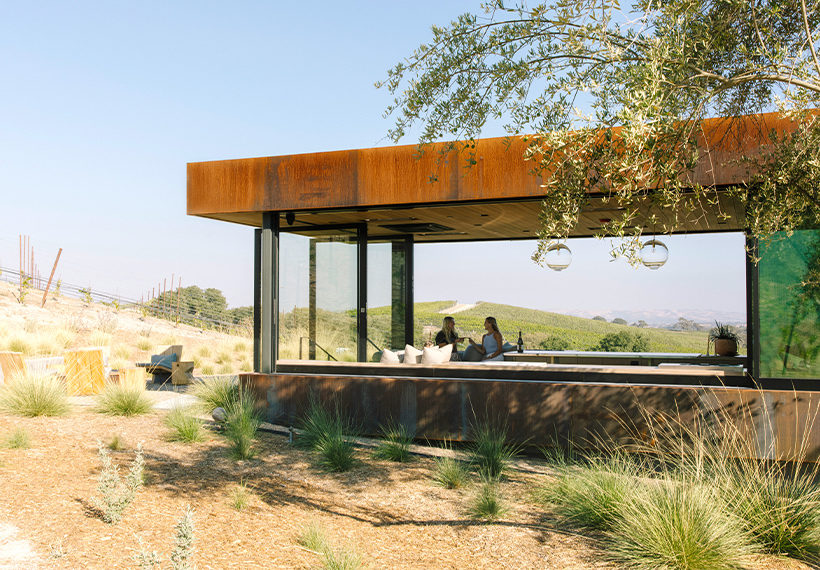
Day 1
Hiking through fog and drinking with renegade winemakers
It’s morning on the California Coast, and if you’ve ever lived here, you know what I’m looking at: fog. I’m standing on the boardwalk that runs along the bluff above Moonstone Beach, just to the west of the tiny town of Cambria. The number one mistake visitors to Pacific beaches make is to dress for summer, but as a UC Santa Barbara alum (class of 2003), I came prepared, with a thick surf hoodie.
It has been nearly two decades since I graduated, and while I’m looking forward to strolling down Memory Lane in Santa Barbara, I’ve decided to make a road trip out of this visit and check off a few Central Coast sights I missed back then—starting with this stretch of beach about two hours north of the city. There may not be any sun glinting off the water, but as I walk up and down the coast, I am able to spot a few things through the marine layer. The dark, pebbly beach is littered with driftwood, while the water is full of wet suit–wearing surfers lining up to catch the waves.
I finish my stroll and hop back in the car to drive south on Route 1. Half an hour later, I reach the three-block-long main drag of Cayucos. The clock has just struck 11 a.m., so Ruddell’s Smokehouse is open. A local favorite for 20 years, the restaurant is run out of a small beachfront shack and specializes in smoked seafood. I mosey up to the counter to order a couple of salmon tacos, which come laden with lettuce, tomato, celery, carrot, apple, and mustard aioli. I chow down as I watch a fisherman at the end of the Cayucos Pier reel in a couple of good-size mackerel. Let’s toss those bad boys in the smoker!
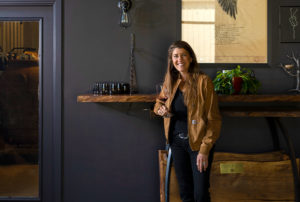
Fortified for the afternoon, I turn onto Old Creek Road, which winds up through a narrow canyon dotted with oaks. When I hit Highway 46, the golden hills begin to be stitched with grapevines, so I know I’m approaching Paso Robles. The world has known about Napa’s wines for decades, and about Santa Barbara’s since Sideways, and Paso has recently staked its own claim to fame. I’ve driven through many times, but never stopped to smell the rosés; today, I make amends.
First up is Booker Vineyard. Stationed on a hillside amid pristine vineyards, the show-stopping new tasting room, which opened in March, wouldn’t look out of place on the front of a brochure for any wine region in the world. There’s definitely Paso-style grit to go with the glitz, though: As I sip a glass of Fracture, the winery’s signature syrah, cowboy-hatted winemaker Eric Jensen pulls up through the vines on an ATV. He offers me a ride up to the ridgetop, liberally sprinkling in profanities as he tells me about the area.
“Paso’s the greatest anomaly in American winemaking, in that it’s all renegades,” he says. “People like Stephan Asseo from L’Aventure, who escaped regulation in Bordeaux, guys like me who were in the music business, people in Tin City who like wine so much they’re like, ‘F*** it,’ and they scratch a couple of nickels together and charge $40 for a syrah that’s worth $120. It’s bada**, and the wines are incredible.”
Among Jensen’s contemporaries, few embody the spirit of Paso better than the eponymous owner of the McPrice Myers Winery. In the barrel room, the burly, workshirt-wearing Myers, who goes by “Mac,” places an empty glass on the running board of a forklift and pours me a sample of his Beautiful Earth Red (a blend of grenache, syrah, and mourvèdre). Myers, who grew up east of Los Angeles in Whittier, discovered wine while working at a Trader Joe’s and went on his first tasting trip in Paso more than two decades ago. The place, he says, grabbed hold of him.
“The camaraderie here is huge,” Myers says. “There’s friendly competition, but it never gets in the way of the passion and the fun. We all want to make world-class wine.”
Perhaps the place that best captures the spirit of this region is Tin City, an industrial compound on the edge of downtown Paso that houses more than two dozen wineries, breweries, and restaurants. I have a few minutes before dinner, so I poke my head into Desparada Wines. On the back porch, winemaker Vailia From pours me a sample of her Wayfinder chardonnay while we watch unsuspecting flies land on the Venus flytrap on the table. When I turn my recorder on, she warns me, “I drop a lot of F-bombs.” I note that this seems to be a common trait among the vintners here.
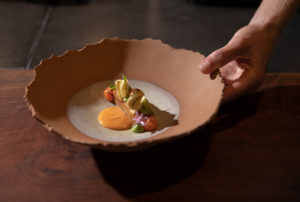
“It’s very relaxed,” From responds, laughing. “I love Napa and Sonoma, but I really appreciate what we have here. We have an incredibly diverse area where we’re not tied to certain varietals, so I see everything being made. I think we’re really lucky.” Speaking of lucky, I’ve scored one of the 12 counter seats at Six Test Kitchen, which opened in Tin City in 2019. The space is small, but the tasting menu is mighty. I quickly lose track of the number of courses, but the highlights include hamachi sashimi with a salad of tomato, cucumber, and basil; chicken liver topped with plum slices on an anise cake; grilled fish head chawanmushi with koji butter; and house-dry-aged pork loin with peach, bulgur wheat, mustard grain, and a grilled shishito. It’s no wonder the place received a star in the 2021 California Michelin Guide.
After dinner, I buttonhole chef Ricky Odbert, who grew up in nearby Arroyo Grande, then cooked in San Francisco kitchens such as Masa’s, Spruce, and Aziza before coming home. While his dining room feels like something you might find South of Market, a lot of local love goes into it.
“The guy that we get our fish from, I literally grew up across the street from him,” Odbert says. “The person we get our produce from, I went to high school with her brothers. I’ve known these people forever, which I wouldn’t get anywhere else.”
I’m ready for bed now, and there’s one waiting for me just on the other side of the Cuesta Grade. I glide down the hill, and before I know it I’m pulling up to the Hotel San Luis Obispo. The two-year-old hotel is on the street that was once the center of SLO’s Chinatown. In the 1870s, during the construction of the railroads, the small city had the largest Chinese population in California, and the property pays homage to that history with a latticed terracotta facade. I have a good view of it from the balcony of my third-floor room, where I can also watch the fog creeping around the volcanic hills that surround town. Where did I put that hoodie?
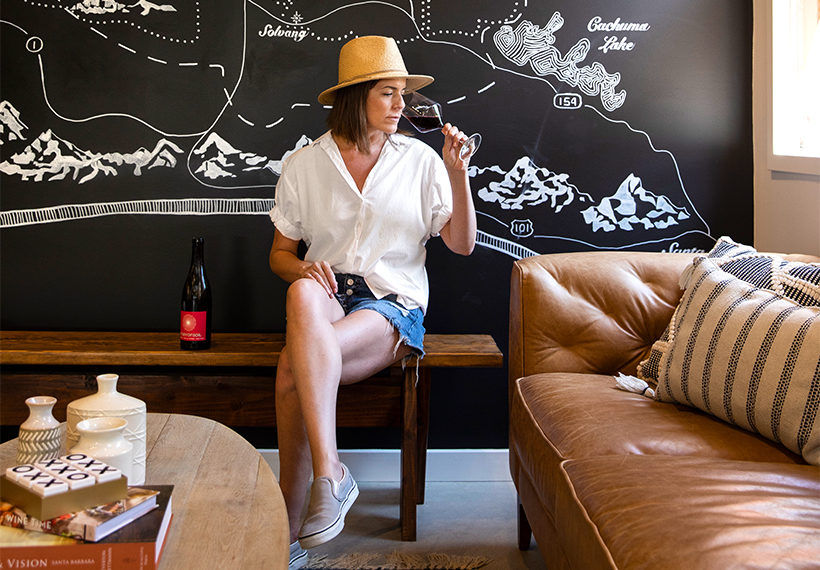
Day 2
A Danish detour and a surprising Indian feast
Any self-respecting college town has a hip coffee shop or two, and the home of Cal Poly San Luis Obispo is no exception. I start my morning with a stroll around the Mission San Luis Obispo de Tolosa, which was founded in 1772, and over to Kreuzberg California. Named for an artsy district in Berlin, the spacious café is decorated with bold murals and portraits of writers and artists. I order a latte and an açaí bowl and sit under an image of Proust, preparing for all the remembrances of things past that I’m about to experience.
Back in the car, I follow 101 south for a few miles, but instead of making straight for Santa Barbara, I take a detour into the Santa Ynez Valley. My first stop on the side-trip is Solvang, a village that was founded in 1911 by a group of Danes who built a town center straight out of a Hans Christian Andersen story: windmills, steep gabled roofs, old-fashioned clocktowers.
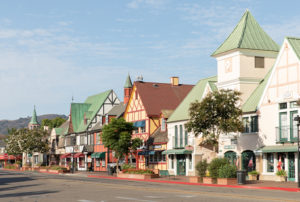
Just 10 more minutes on a quiet country road brings me to Los Olivos, a small town that’s not only the nexus of Santa Barbara wine country, but also the setting of one of my favorite films. After parking the car, I make a small personal pilgrimage, wandering past the tasting rooms on Grand Avenue to the alley next to the Los Olivos Wine Merchant Café, where I quietly mutter, “I am not drinking any f****** merlot,” as Paul Giamatti’s Miles did (less quietly) in Sideways.
There are plenty of wines I will drink, though. First, I pop into Story of Soil. Winemaker Jessica Gasca—who, in cutoff jean shorts, a white button-down, and a straw hat, looks like Sandra Bullock if she were a Wine Enthusiast cover model—pours me a taste of her earthy Duvarita Vineyard pinot noir, and we sit in front of a chalk map of the Central Coast’s appellations and chat about the land and the people who work it.
“At harvest, you wake up at the crack of dawn, get to the vineyard, and all of a sudden you’re in nature, with an incredible group of people that are working the land. It’s magical.” As both a Mexican American and the president of the Santa Barbara Vintners Foundation, Gasca makes a point to take care of those people. “We were able to bring mobile medical units into the vineyards and vaccinate more than a thousand workers. I feel like we forget that we have wine to drink only because of the people who work the land.”
Next, I walk a couple of blocks to Brewer-Clifton, where I’m greeted by Greg Brewer, who last year was named winemaker of the year by Wine Enthusiast. The honor doesn’t seem to have gone to his head: He’s dressed casually, in a black V-neck that reveals arms tattooed with bamboo and an octopus, and as we sip a beautiful 2015 3D pinot noir in his Japanese-inspired tasting room, he describes the recognition as being for the region, not himself.
“I’ve only worked in Santa Barbara,” Brewer tells me. “It’s like when you really commit yourself to somebody, you can surrender to that person, right? I surrender to this landscape. So the award wasn’t about me. It goes to everyone who came before, everyone in the game now, those that will come later—we all own that award, because I’m this place.”
Lunch is in the Old West–style town of Santa Ynez, at S.Y. Kitchen, an acclaimed restaurant run out of a ranch house by the Italian chef brothers Luca and Francesco Crestanelli. I sit on the brick patio, where I can smell the wood burning in the outdoor pizza oven. Duly inspired, I order the special, a black truffle pizza that I would put up against any pie in New York, along with a salad of yellow beets shaved paper-thin and a spaghetti alle vongole bursting with fresh clams. It’s way too much food—and I want seconds of all of it.
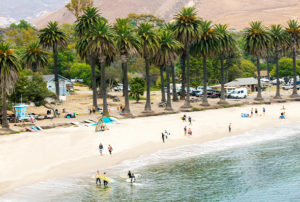
Feeling great about that detour, I head back to 101 and slalom toward the coast. The brilliant blue Pacific is on my right for this stretch, and I pull off to get some sand between my toes at Refugio State Beach.
My next stop on Memory Lane is The Ritz-Carlton Bacara, a 78-acre resort just north of Isla Vista, where many of my friends worked during college. I take in the clifftop view of the ocean and the off-shore oil rigs—Jim Morrison’s inspiration for “The Crystal Ship”—and then make for the 42,000-square-foot spa. My choice of treatment, the signature massage, basically consists of a therapist spending 80 minutes using two hot stones to grind me down to Goldman dust—a very relaxed, satisfied Goldman dust.
As beautiful as the Bacara is, tonight I’m staying downtown, at the Palihouse Santa Barbara. The decor is quintessential Spanish Colonial Revival: white stucco walls, arched doorways, exposed wood beams, red clay roof tiles. This style defines Santa Barbara, in particular on the main drag, State Street, which owes its uniform appearance to having been rebuilt after an earthquake struck in 1925.
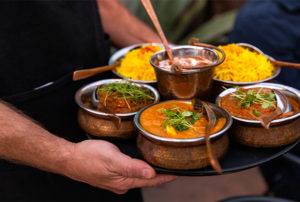
While the buildings may look the same as when I lived here, many of them now house hipper tenants, such as the three-year-old, Michelin-recommended Indian restaurant Bibi Ji. I sit on the back patio and ask my purple-haired server, Alvaro, for some guidance. “The dal is my favorite,” he replies. “I recommend drinking that through a straw.” I order that, along with mysore bonda (potato-pea fritters with okra raita) and halibut moilee (lightly fried local halibut with curry sauce). I think I can’t possibly eat anymore, until Alvaro delivers an order of uni, served on the spiny half shell. I’m astonished by how good everything is; 20 years ago, there was nothing like this in Santa Barbara.
I’m almost tapped out, but there’s one other trendy newcomer that needs investigating. Venus in Furs, opened last year by the owners of the best cocktail bar in the city, The Good Lion, is a different kind of wine bar. The name is a Velvet Underground reference, the soundtrack is new wave rock, and the tasting notes are more tongue-in-cheek than nose-in-glass (“silky as ur nonna’s nighty”). I sip a Stolpman syrah blend while contemplating the Indian-style mural of peacocks in the jungle that adorns the back bar. This feels like the kind of place Lou Reed might have frequented when he was in the mood for something a little softer. Maybe I could say that about all of downtown SB?
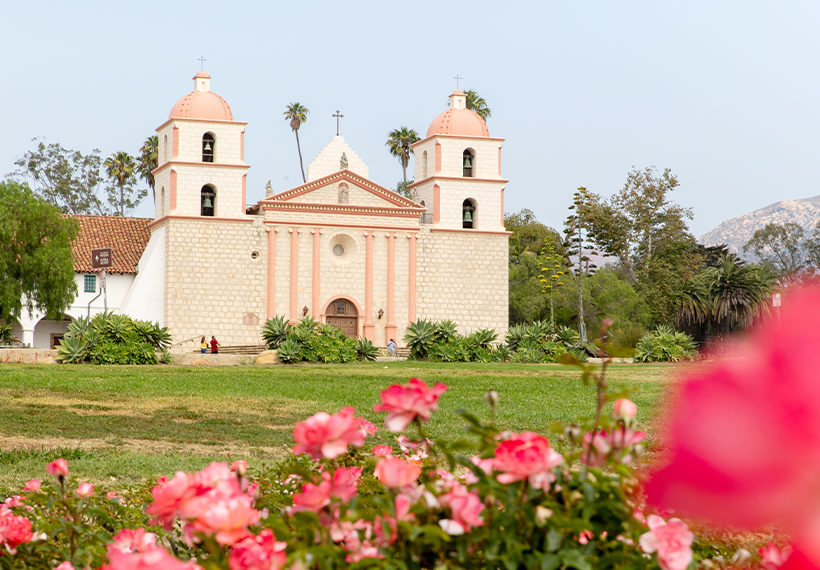
Day 3
Setting sail from the harbor and dining at a pair of old favorites
I want to keep last night’s trendiness going, so I start my morning at Alessia Patisserie + Cafe. The bright space, which opened in July, feels both modern and classic, with its display case of architectural pastries and playlist of chanteusey jazz. As I sit by the window, drinking a latte and eating a fantastic chocolate croissant, I watch a two-tone ’50s Chevy Bel Air park across the street in front of the 1782 El Presidio de Santa Bárbara. What century am I in, again?
I’m about to take a mode of transportation that’s more dated than that Bel Air: a charter cruise with the Santa Barbara Sailing Center. I meet my skipper, Larry, at the harbor, and he leads me out on the dock to the 42-foot Calafia. As the yacht pulls away from the marina, he tells me to take the wheel. “The person at the helm is always the skipper,” he says. “Now aim for those kayakers over there—we’ll scare the crap out of them.” I don’t ram any kayakers, or the buoy occupied by barking sea lions, but as we cruise to open water Larry dispenses wisdom about life at sea (“If you have to fight the wheel, you have too much sail out”) and on land (“I got on a plane to Santa Barbara in 1971, and I never looked back”). There’s not much wind, so when we cut the engine we mostly bob in place, looking back toward East Beach and the Santa Ynez Mountains. In the back of my mind I hear Jimmy Buffett: Mother, mother ocean, I have heard you call…
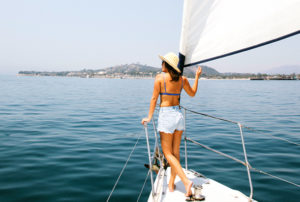
Being a mariner is hard work, and I think I’ve earned lunch. Upon docking, I drive over to Milpas Street, long the main drag for Santa Barbara’s Mexican community. A lot has changed in this town in recent years, but some things have justifiably stayed the same, including La Super-Rica Taqueria. The small restaurant became famous for being Julia Child’s favorite place in town, and that notoriety resulted in an ever-present line. I queue up outside, grumbling, but when I see an old woman in the kitchen shaping fresh masa into tortillas, I know it’ll be worth the wait. I order the Super-Rica Especial, cheese-stuffed pasilla peppers served with marinated pork and those tortillas. The food is creamier than standard taqueria fare—perhaps explaining why America’s most famous French chef loved it so. And who am I to argue with Julia Child?
Next, I’m off to an even more venerable local landmark: the Old Mission Santa Bárbara.
The church has been through a few, ahem, resurrections since it was established in 1786 (two of them following earthquakes in 1812 and 1925). On the self-guided tour, I soak up the history: the 1808 Moorish fountain, the lavandería where the Chumash people did laundry, the 130-year-old Moreton Bay fig tree in the cemetery, the pictures of the von Trapp family visiting in the early 1950s.
Not quite as old is the Santa Barbara Museum of Art. The 80-year-old museum, which is mostly housed in a 1912 post office building, fully reopened in August, following a $50 million renovation. The museum’s director, Larry Feinberg, and deputy director and chief curator, Eik Kahng, meet me in the reimagined entryway. Standing below a 2nd-century CE Roman statue of Hermes, we look up through a trio of restored archways at an Anish Kapoor sculpture on the second floor; the walls around us are lined with everything from early-20th-century American paintings to pre-Columbian pottery.
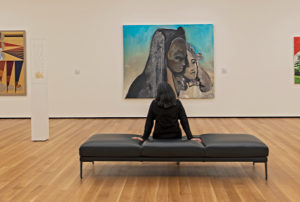
“I kind of like the non-hierarchical aspect of the salon-style hang,” Kahng says, “because you have a dialogue between different cultures.” As for the showstopping centerpiece? “When I first arrived 10 years ago, Hermes was almost at human level, but the original would have been elevated. It completely changes your relationship to him. He’s a god,” she adds, laughing, “so of course he should be looking down at you.”
I feel like a god myself when I check into my hotel, the Rosewood Miramar Beach, a seaside estate in posh Montecito, just east of downtown. Then I hop a cab back to the Funk Zone for happy hour. Split by railroad tracks, this formerly industrial district at the bottom of State Street is replete with graffiti murals, hip restaurants, and, naturally, an urban wine trail. I start with a glass of pinot noir at the grandest of the tasting rooms, Margerum Wine Company, which is attached to the swank Hotel Californian, and then pop a block over to the more under-the-radar Skyenna, where winemaker Lenny Germano, a New Jerseyite gone native, pours me a tempranillo. “When I nabbed this spot, it was a dark little hole,” he says. “I’ve really watched this area change in the last five years. The city gets it—they like the funkiness of it.”
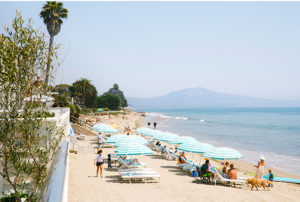
I’ve been enjoying the wine so much that I realize I’m about to be late for my dinner reservation. Much of my day has been spent visiting SB classics, and La Paloma Café is the one closest to my heart. It first opened as a Mexican restaurant in 1940—witness the Aztec-themed mural above the bar—and later became the Paradise Café. I loved the Paradise and was devastated when it closed last year, but I was heartened when Acme Hospitality, the owners of my other favorite restaurant in town, The Lark, brought it back under its original name.
I’ve been looking forward to this meal all weekend, and making it even more special is that my three college roommates, Matt, Josh, and Rob, are joining for an impromptu reunion. We sit on the terraced patio and get to work on a pitcher of the eponymous cocktail (tequila, Aperol, lime, agave, grapefruit) before going nuts on the menu: raw Kumai oysters, grilled artichoke, vegetable pozole, ceviche made from local fish, slow-cooked pinquito beans, smoky Santa Maria–style wagyu tri-tip, tender pork-shoulder carnitas. At the end of the meal, Josh, who loved the previous incarnation of this place even more than I did, matter-of-factly says, “I do not miss the Paradise.”
As we all hop in a car and head back to the Rosewood for a nightcap, I feel myself getting a little misty. I spent some of the best years of my life here, with these people, and while neither the city nor my friends have remained the same, we’ve grown up and—dare I say—become cooler. As we sit on the hotel veranda, looking at the light from inside glinting off the pool, I hear a train whistle. A single track runs through the property, and as the boxcars pass by, due south, I wonder where we’re all headed. One thing I don’t wonder, though, is where I feel most at home.
Next Up: Napa Valley, Sonoma, Central Coast: Your Guide to California Wine
Fly to the American Riviera in One Stop or Less: Santa Barbara is only a nonstop flight away from Chicago O’Hare, Denver, Los Angeles, and San Francisco. Book your trip on united.com or the United app.
